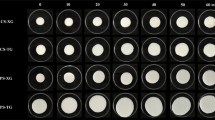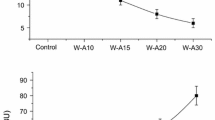Abstract
The objective of this study was to assess the combined effect of guar gum (GG) and water content (WC) on the rheological properties of batter, and the physicochemical and textural properties of bread. Batches of gluten-free bread used a base formulation of rice (50%), maize (30%) and quinoa flour (20%), with different levels of GG (2.5, 3.0 or 3.5%) and water (90, 100 or 110%) in a full factorial design. Higher GG doses (p < 0.001) tended to produce batters of lower stickiness, work of adhesion and cohesive strength; yet, of higher firmness, consistency, cohesiveness and viscosity index. These batters yielded loaves of lower (p < 0.001) specific volume and baking loss; and crumbs of lower (p < 0.001) aw, pH, mean cell area, void fraction, mean cell aspect ratio; and higher (p < 0.001) hardness, adhesiveness, springiness, cohesiveness, chewiness, resilience, mean cell density, cell size uniformity and mean cell compactness. The sticker and less consistent batters produced with higher WC rendered larger bread loaves of softer and more cohesive and springy/resilient crumbs with greater mean cell size and void fraction. Gluten-free loaves of good appearance in terms of higher specific volume, lower crumb hardness, higher crumb springiness, and open grain visual texture were obtained in formulations with 110% WC and GG doses between 2.5 and 3.0%.







Similar content being viewed by others
References
Foschia M, Horstmann S, Arendt EK, Zannini E (2016) Nutritional therapy—facing the gap between coeliac disease and gluten-free food. Int J Food Microbiol 239:113–124
Naqash F, Gani A, Gani A, Masoodi FA (2017) Gluten-free baking: combating the challenges—a review. Trends Food Sci Technol 66:98–107
Ghodke SK (2009) Effect of guar gum on dough stickiness and staling in chapatti-an Indian unleavened flat bread. Int J Food Eng 5(3):article 7
Moreira R, Chenlo F, Torres MD (2013) Effect of chia (Sativa hispanica L.) and hydrocolloids on the rheology of gluten-free doughs based on chestnut flour. LWT-Food Sci Technol 50(1):160–166
Conte P, Del Caro A, Balestra F, Piga A, Fadda C (2018) Bee pollen as a functional ingredient in gluten-free bread: a physical-chemical, technological and sensory approach. LWT-Food Sci Technol 90:1–7
Mohammadi M, Azizi M-H, Neyestani TR, Hosseini H, Mortazavian AM (2015) Development of gluten-free bread using guar gum and transglutaminase. J Ind Eng Chem 21:1398–1402
Sahraiyan B, Naghipour F, Karimi M, Davoodi MG (2013) Evaluation of Lepidium sativum seed and guar gum to improve dough rheology and quality parameters in composite rice-wheat bread. Food Hydrocoll 30(2):698–703
Pellegrini M, Lucas-Gonzales R, Ricci A, Fontecha J, Fernández-López J, Pérez-Álvarez JA, Viuda-Martos M (2018) Chemical, fatty acid, polyphenolic profile, techno-functional and antioxidant properties of flours obtained from quinoa (Chenopodium quinoa Willd) seeds. Ind Crops Prod 111:38–46
Elgeti D, Nordlohne SD, Föste M, Besl M, Linden MH, Heinz V, Jekle M, Becker T (2014) Volume and texture improvement of gluten-free bread using quinoa white flour. J Cereal Sci 59(1):41–47
Renzetti S, Rosell CM (2016) Role of enzymes in improving the functionality of proteins in non-wheat dough systems. J Cereal Sci 67:35–45
Cornejo F, Rosell CM (2015) Physicochemical properties of long rice grain varieties in relation to gluten free bread quality. LWT-Food Sci Technol 62(2):1203–1210
Devi PB, Kavitake D, Shetty PH (2016) Physico-chemical characterization of galactan exopolysaccharide produced by Weissella confusa KR780676. Int J Biol Macromol 93:822–828
Agrahar-Murugkar D, Gulati P, Kotwaliwale N, Gupta C (2015) Evaluation of nutritional, textural and particle size characteristics of dough and biscuits made from composite flours containing sprouted and malted ingredients. J Food Sci Tech 52(8):5129–5137
Juszczak L, Witczak T, Ziobro R, Korus J, Cieślik E, Witczak M (2012) Effect of inulin on rheological and thermal properties of gluten-free dough. Carbohydr Polym 90(1):353–360
AACC International (2000) Method 10-05, approved methods of the AACC, 10th edn. American Association of cereal chemists, St. Paul
Sabanis D, Tzia C (2010) Effect of hydrocolloids on selected properties of gluten-free dough and bread. Food Sci Technol Int 17(4):279–291
Bhatt SM, Gupta RK (2015) Bread (composite flour) formulation and study of its nutritive, phytochemical and functional properties. J Pharmacogn Phytochem 4(2):254–268
Turkut GM, Cakmak H, Kumcuoglu S, Tavman S (2016) Effect of quinoa flour on gluten-free bread batter rheology and bread quality. J Cereal Sci 69:174–181
Machado-Alencar NM, Steel CJ, Alvim ID, Carvalho de Morais E, Andre-Bolini HM (2015) Addition of quinoa and amaranth flour in gluten-free breads: temporal profile and instrumental analysis. LWT-Food Sci Technol 62(2):1011–1018
Razavizadegan-Jahromi SH, Karimi M, Yazdi FT, Mortazavi SA (2014) Response surface optimization of Barbari bread-making process variables: interrelationship of texture, image and organoleptic characteristics; using image analysis for quality and shelf life prediction. J Food Process Preserv 38(4):1608–1621
Motta-Romero H, Santra D, Rose D, Zhang Y (2017) Dough rheological properties and texture of gluten-free pasta based on proso millet flour. J Cereal Sci 74:238–243
Martínez MM, Gómez M (2017) Rheological and microstructural evolution of the most common gluten-free flours and starches during bread fermentation and baking. J Food Eng 197:78–86
Gonzales-Barron U, Butler F (2006) A comparison of seven thresholding techniques with the k-means clustering algorithm for measurement of bread-crumb features by digital image analysis. J Food Eng 74(2):268–278
Gonzales-Barron U, Butler F (2008) Discrimination of crumb grain visual appearance of organic and non-organic bread loaves by image texture analysis. J Food Eng 84(3):480–488
Matlab software (2015) “Version R2015a”. Natick. Massachusetts, The MathWorks Inc., USA
McNeish DM, Harring JR (2017) Clustered data with small sample sizes: comparing the performance of model-based and design-based approaches. Commun Stat Simul Comput 46(2):855–869
R Core Team (2018) R: a language and environment for statistical computing. R Foundation for Statistical Computing, Vienna, Austria. http://www.R-project.org/. Accessed 4 Feb 2018
Han HM, Cho JH, Kang HW, Koh BK (2012) Rice varieties in relation to rice bread quality. J Sci Food Agric 92(7):1462–1467
Sciarini LS, Ribotta PD, León AE, Pérez GT (2010) Influence of gluten-free flours and their mixtures on batter properties and bread quality. Food Bioprocess Tech 3(4):577–585
Giri S, Banerji A, Lele SS, Ananthanarayan L (2017) Effect of addition of enzymatically modified guar gum on glycemic index of selected Indian traditional foods (idli, chapatti). Bioact Carbohydr Dietary Fibre 11:1–8
Funami T, Kataoka Y, Omoto T, Goto Y, Asai I, Nishinari K (2005) Food hydrocolloids control the gelatinization and retrogradation behavior of starch. 2a. Functions of guar gums with different molecular weights on the gelatinization behavior of corn starch. Food Hydrocoll 19(1):15–24
Horstmann SW, Axel C, Arendt EK (2018) Water absorption as a prediction tool for the application of hydrocolloids in potato starch-based bread. Food Hydrocoll 81:129–138
Sanguinetti AM, Secchi N, Del Caro A, Fadda C, Fenu PAM, Catzeddu P, Piga A (2015) Gluten-free fresh filled pasta: The effects of xanthan and guar gum on changes in quality parameters after pasteurisation and during storage. LWT-Food Sci Technol 64(2):678–684
Hager A-S, Wolter A, Czerny M, Bez J, Zannini E, Arendt EK, Czerny M (2012) Investigation of product quality, sensory profile and ultrastructure of breads made from a range of commercial gluten-free flours compared to their wheat counterparts. Eur Food Res Technol 235(2):333–344
Marti A, Marengo M, Bonomi F, Casiraghi MC, Franzetti L, Pagani MA, Iametti S (2017) Molecular features of fermented teff flour relate to its suitability for the production of enriched gluten-free bread. LWT-Food Sci Technol 78:296–302
de la Hera E, Rosell CM, Gómez M (2014) Effect of water content and flour particle size on gluten-free bread quality and digestibility. Food Chem 151:526–531
Onyango C, Mutungi C, Unbehend G, Lindhauer MG (2011) Modification of gluten-free sorghum batter and bread using maize, potato, cassava or rice starch. LWT-Food Sci Technol 44(3):681–686
Lee H, Coates GA (2003) Effect of thermal pasteurization on Valencia orange juice color and pigments. LWT-Food Sci Technol 36(1):153–156
Schober TJ, Messerschmidt M, Bean SR, Park S-H, Arendt EK (2005) Gluten-free bread from sorghum: quality differences among hybrids. Cereal Chem 82(4):394–404
Acknowledgements
Eng. Encina-Zelada acknowledges the financial aid provided by the Peruvian National Programme of Scholarships and Student Loans (PRONABEC) in the mode of PhD grants (Presidente de la República-183308). The authors are grateful to Eng. Andrea Oliveira from Prodipani, Portugal, for her kind advice and providing breadmaking ingredients.
Author information
Authors and Affiliations
Corresponding author
Ethics declarations
Conflict of interest
The authors declare that they have no conflict of interest.
Research involving human participants and/or animals
This article does not contain any studies with human or animal subjects.
Rights and permissions
About this article
Cite this article
Encina-Zelada, C.R., Cadavez, V., Monteiro, F. et al. Physicochemical and textural quality attributes of gluten-free bread formulated with guar gum. Eur Food Res Technol 245, 443–458 (2019). https://doi.org/10.1007/s00217-018-3176-3
Received:
Revised:
Accepted:
Published:
Issue Date:
DOI: https://doi.org/10.1007/s00217-018-3176-3




